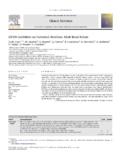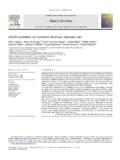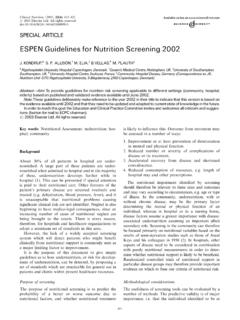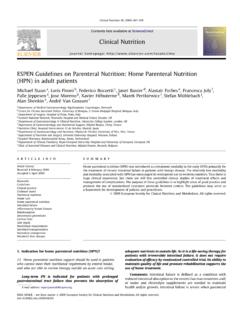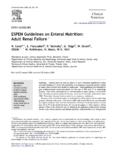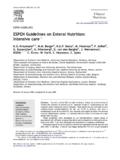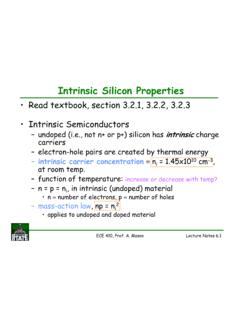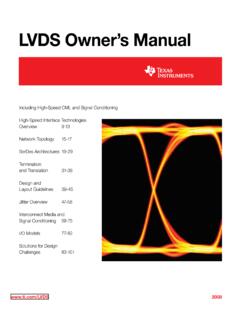Transcription of 11. Home Parenteral Nutrition in Children - ESPEN
1 11. home Parenteral Nutrition in ChildrenMETHODSL iterature SearchTimeframe: publications from 1990, but single publicationsfrom 1980 onward were also of publications: case-control or cohort Words: Children , Parenteral Nutrition (PN), home , long-term, cost, quality of life, complications, liver disease, meta-bolic bone disease, catheter-related sepsis, : Start an HPN Programme?In Children , as in adult patients, long-term total or com-plementary PN is required to preserve nutritional statuswhen oral or enteral Nutrition cannot provide protein-energy needs, especially in diseases which impair diges-tive function. When a child does not need hospitalizationbut depends on long-term PN, home PN (HPN) is analternative to prolonged hospitalisation and is recognizedas the best option for improving the quality of life ofthese Children and their families within the constraintsof the DiseaseThe main indications for prolonged PN and thus HPNin Children are primary digestive diseases causing in-testinal failure 1.
2 Short bowel syndrome ((2) (LOE 4); (3)(LOE 4); (4) (LOE 4)), mainly congenital, is the largestgroup, accounting for at least 30% of cases in the majorpublished surveys ((5) (LOE 3); (6) (LOE 3); (7) (LOE3)). The main other digestive indications are intractablediarrhoea of infancy ((8) (LOE 3)), chronic intestinalpseudo-obstruction ((9) (LOE 3)) and inflammatorybowel diseases, especially Crohn s disease. Primary non-digestive indications such as immune deficiency includingAIDS, tumours, metabolic diseases, and end stage liverdiseases before transplantation account for about 20% ofpatients. The need for HPN in these diseases is usuallyshorter than for primary digestive for safely commencing PN at home dependson each individual condition. Most paediatric HPNprogrammes cater for Children under one year old andinclude babies under the age of 6 months ((5) (LOE 3);(7) (LOE 3)).ConditionPatients eligible for HPN should be in a stablecondition.
3 This includes stability of the underlying dis-ease, fluid and electrolyte requirements, and reliablecentral venous and Familial Requirements for HPNW hatever the medical indication, some social andfamilial criteria have to be fulfilled before a child s HPNprogramme is organized. Parents have to be informed,motivated and should be able to cope with all medical,emotional and technical problems related to suitability for HPN must be carefully assessedby a health care team member ((10) (LOE 4)). This mayinclude visiting the home , to examine practical detailssuch as space for dedicated refrigerator, electricity, andconnected telephone ((11) (LOE 4); (12) (LOE 4)).Theassistance of a social worker, before discharge, is needed,especially the home environment is inadequate ( facilities on the same level as the child sbedroom). In other cases, the professional status of bothparents needs to be carefully examined, for occasionallyone of them has to stop working.
4 In one-parent house-holds, the mother is usually the parent responsible foradministering HPN. A single-parent family is not alwaysa contraindication for HPN, but social help and homenursing assistance may become necessary ((5) (LOE 3);(6) (LOE 3)). Separated parents who share the child scare should be trained providing they each connect/dis-connect the PN at least once a week to maintain SavingsHPN is an expensive technique. The annual cost ofHPN per patient, including nutrients, pump and dispos-able equipment, was evaluated to amount to about 60,000to 80,000 ((11) (LOE 4)) in England ((13) (LOE 2+)),but as much as 100,000 to 150,000 US dollar in the USA((14) (LOE 4); (15) (LOE 4)). However, cost-benefitstudies have demonstrated that HPN is about 65% morecost-effective than hospital treatment for Children as forJournal of Pediatric Gastroenterology and Nutrition41:S70 S75 November 2005 ESPGHAN. Reprinted with ((16) (LOE 2++); (14) (LOE 4); (13) (LOE 2+)).
5 The longer a patient survives on HPN, the more cost-effective home -treatment becomes. A paediatric studyshowed that HPN in the UK led to cost savings of about2 millions euros in a single year by the decrease in theincidence of septic episodes from 1/142 days in hospitalto 1/567 days at home ((17) (LOE 2+)).PREPARATION OF AN HPNPAEDIATRIC PROGRAMMEP rior to discharge, parents must undergo structuredtraining in all aspects of care and complications ((18)(LOE 3); (6) (LOE 3); (11) (LOE 4); (12) (LOE 4), (19)(LOE 4)). The teaching programme should begin assoon as the decision to proceed to HPN has been taken. Itis best undertaken during the period when at least oneparent, or preferably both, is resident in the hospital,especially if the family lives far from the HPN mean duration of the teaching programme is about2 weeks ((6) (LOE 3); (11) (LOE 4)), but the durationneeds to be tailored to each family s needs. The struc-tured teaching programme must have a written plan, stepby step instructions and a method to record competencecomprising theoretical and practical aspects.
6 Writtenand audiovisual tools may be used. Each session islimited to learning one particular skill, and a new subjectshould only be introduced when parents are competentand confident in the previous one. A written record ofprogress should be kept (Table ). Some teams recom-mend that the parents spend 1 to 2 nights with their childin a special isolation room, close to the medical unitbut without any help from hospital nurses, to simulatehome conditions and to assess their autonomy, just beforethe family returns home ((6) (LOE 3)). When parentscannot be autonomous, especially in case of a singleparent family, the help of a community nurse is required((6) (LOE 3); (12) (LOE 4)). In some countries, candi-dates for HPN can be referred to outside service organi-zations, which use nurses who sometimes meet thefamily in the hospital for the first encounter and thenvisit the patient at home to complete the training givenat the hospital.
7 Community health professionals shouldbe involved in all aspects of discharge planning andsubsequent shared care ((11) (LOE 4); (20) (LOE 4); (21)(LOE 4)). The physician and the teaching nurse from theHPN centre should inform staff from the patient s localhospital about guidelines for emergencies such as fever,pump or line failure ((11) (LOE 4)). This may be done byholding a discharge planning meeting attended byparents and all professionals involved in the child s is best held at the patient s local hospital. Thoseattending may include the child (if old enough), parents,members of the specialist Nutrition team, local paediatri-cian and a nurse from the local hospital, communitynurse and the patient s general AccessChildren on HPN require a reliable central venous ac-cess (see chapter on venous access). No data is availableto compare implanted ports with Broviac-type cathetersfor paediatric HPN use in terms of quality of life andcomplications.
8 Extensive thromboses are a possible prob-lem in patients who receive HPN over long periods ofTABLE knowledge required before home discharge on HPNP arents knowledgeHandlingCatheter and linePumpChildCurrent careHand washing techniquePreparation of sterile fieldDrawing up solutions intosyringeFlushing or heparinisationInitiation and termination ofinfusionOperationMaintenanceCatheter exit siteTemperatureEmergencyWhat to do?Who to contact?Materials missingBlockage of lineBreakage/split catheterAir in the lineAlarmsExit siteInfectionFeverDigestive problemStatement and Recommendation HPN is less costly than hospital 2+ All Children who depend on long-term PN shouldbe discharged on HPN, if familial criteria DRecommendations Parents should undergo a structured teaching andtraining programme, conducted by a nurse fromthe HPN centre s Nutrition support D Parents skills and knowledge should be checkedbefore home D Community health professionals and staff fromthe local hospital should be involved in all aspectsof discharge planning and subsequent shared DGUIDELINES ON PAEDIATRIC Parenteral NUTRITIONS71J Pediatr Gastroenterol Nutr, Vol.
9 41, Suppl. 2, November 2005time. In these circumstances, alternative sites for venousaccess may need to be used. Rarely, arterio-venousfistulae can be used for long-term HPN programs, es-pecially in the case of repeated catheter complications((6) (LOE 3)).The Infusion CycleHPN is based on cyclical (10 to 18 hours per day) Parenteral infusion of nutrient formula ((6) (LOE 3); (11)(LOE 4)). Children , like adults, almost always toleratea nocturnal infusion over a period of 10 to 12 hours,especially when oral or enteral feeding is possible. Cyclicinfusion has metabolic, physical and psychologic advan-tages. In infants, especially when enteral feeding is nottolerated, or in Children with major digestive fluid andelectrolyte losses, a longer period of infusion is required(14 to 18 hours). When PN is initially started in hospitalall Children are infused continuously 24 hours per then undergo a period of adaptation, during whichtime the rate of infusion is gradually increased and theinfusion period decreased, usually from 24 to 12h perday, and in exceptional circumstances to a maximum of18 hours.
10 A progressive increase and decrease of infusionrate during the initial and final hours of infusion shouldbe considered to avoid hypoglycemia and hyperglycemiain some patients ((6) (LOE 3)).Pumps, Equipment and AncillariesA pump is essential for Parenteral infusion in for PN at home should reach a good compromisebetween safety and comfort. The main requirements forsafety are: volumetric accuracy in wide range of flowrates, no risk of sudden discontinuation of infusion(reliable battery), no risk of free flow, keep vein open status, audible and written alarms ( for air bubbles inline, empty container, occlusion, change in pressure,dose limit or low battery) and child proof ((20) (LOE 4)).Other requirements are also important for the qualityof life: simplicity to prime the set and clear air, pre-selection of infusion rates and of programmed stepwiseincreased and decreased flow rates at the onset and endof the infusion times, minimum false alarms, minimummotor noise, minimum weight and volume with carryinghandle and binding on IV poles.
